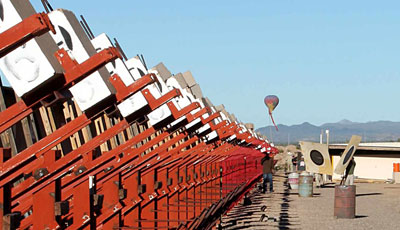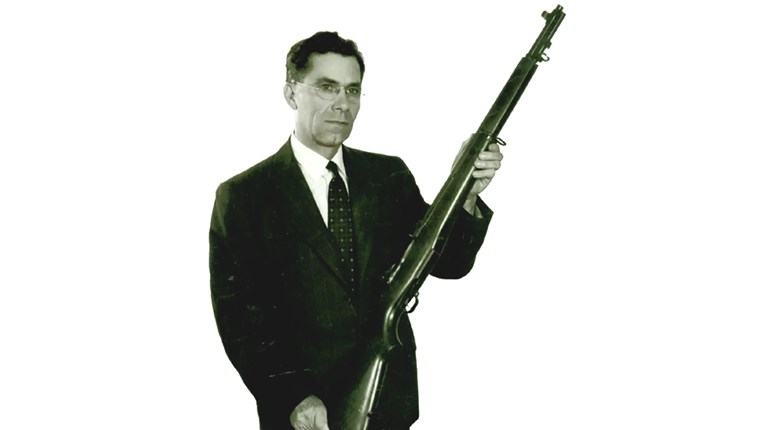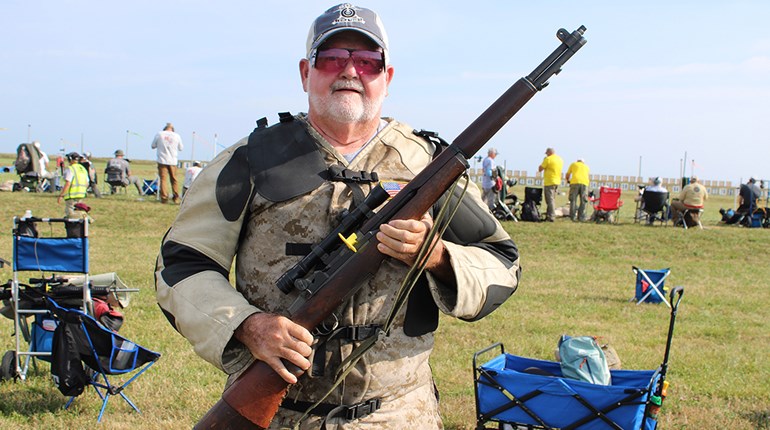

Lining up for squadding by dawn’s early light.
But regardless of your particular shooting discipline, there’s another aspect of interacting and working cooperatively with others, and the familiar almost-paradox of competing against friends, acquaintances and those who share our love of the sport. To quote long-time national and international champion shooter Nancy Tompkins, “If you've got to win to be happy, well, at the Nationals, there's only gonna be one happy person out of 700. When you spend your vacation and all your money to go there, you've gotta enjoy being around the people.”

Life in the pits: bringing out the 600-yard targets. A very nice pivoting, counterweighted target frames on the left and, yes, that’s a hot air balloon in the distance, a common sight early mornings at BASF.
My regular shooting buddy, Ken, couldn’t make the Garand Match, so I went alone. On arrival, I found that the strong winds from the previous night had blown over all the portable toilets. “Hmm,” I thought to myself, “they all fell pointing away from the impact berm. If a wind from 12 o’clock is blowing at 50 mph, does it still have no value?”
The sun was just inching above the horizon when about a hundred of us shooters lined up, and I was squadded with a geologist, Rob, from California. Rob was shooting his second-ever match, using an M1 Garand he purchased from CMP. First, we both went to the pits to pull Target 42 for Relays 1 and 2. Some shooters don’t like pulling targets, but I’ve always enjoyed it as just another part of the game. In fact, while most competitors like to shoot Relay 1, before the wind picks up, I prefer pit pig duty beforehand because it helps me zone in, and be more focused when it’s my turn on the line. Even though providing good pit service is serious duty, there’s still plenty of opportunity for conversation. I became acquainted with Rob, the geologist, and with the pullers on Target 41, a father/son pair also from California. Near the end of our time in the pits, the shooter (on Target 41) put a low shot into the top of the berm, smacking gravel into the target and the target pullers. Startling, for sure, but no harm done, and it even got a few rueful chuckles.

A CMP worker pulls posted match results from their trailer as CMP prepares to pull out at the end of the Games. The life of gypsies—CMP workers were on the road 10 minutes after the awards ceremony concluded.
“Geez, that one missed high,” he said after a shot. His target came up with a miss at 12 o’clock but I encouraged him, “Hey, you’re doing well when you can call your shots.” And you know what? He called all his misses—pretty good for a guy shooting only his second match.
Poor Rob. He had a shooting mat but no jacket; shooting prone in a T-shirt in the Phoenix heat for two days, left his elbows bloody. At the end of the match when he was picking up his gear I asked him, “So, does the blood help your elbows stick to the mat?” “No, not really,” he said, and we laughed.
 The next day Ken, my regular shooting partner, and I carpooled the 70 miles back to the Ben Avery Shooting Facility (BASF) for the Vintage Military Sniper Rifle Two-Man Team Match. We had no time to practice with our M1903A4s, so we went in cold. Ken hadn’t even shot his rifle past 200 yards, so I hit the library and found the come-ups for his original M84 scope. He was on paper right away, but unfortunately, our lack of preparation showed. I had used up so much of the 5-minute sighter period at 300 yards, that Ken was allotted none. A major mistake because finding his way into the X-ring with all shots counting for record cost us too many points. We were smarter at 600 yards, letting Ken shoot sighters first since I already had my 600-yard zero.
The next day Ken, my regular shooting partner, and I carpooled the 70 miles back to the Ben Avery Shooting Facility (BASF) for the Vintage Military Sniper Rifle Two-Man Team Match. We had no time to practice with our M1903A4s, so we went in cold. Ken hadn’t even shot his rifle past 200 yards, so I hit the library and found the come-ups for his original M84 scope. He was on paper right away, but unfortunately, our lack of preparation showed. I had used up so much of the 5-minute sighter period at 300 yards, that Ken was allotted none. A major mistake because finding his way into the X-ring with all shots counting for record cost us too many points. We were smarter at 600 yards, letting Ken shoot sighters first since I already had my 600-yard zero.Unlike the previous day we had almost no wind to contend with, though the hefty desert mirage laying down first right, then left, showed that the limp flags weren’t being entirely truthful. Consequently, at 600 yards, my shots weren’t landing as called.
Bang!
“Center!” I called.
“Two o’clock 9-ring,” Ken responded.
Bang!
“Eight o’clock 10-ring!”
“Eight o’clock 8-ring,” Ken corrected.
That’s when I noticed a crack developing in the stock behind my receiver tang. Long story short, when I uncased the rifle later at home, a thumb-size chunk of wood fell out of the stock behind the tang, and the receiver was loose in the stock. Hmm … do you think that could explain the group size expanding at 600 yards?
Ken also learned that his M84’s center post completely obliterates the entire target at 600 yards, requiring a change to a “stick & lollipop” sight picture and six o’clock hold.

The organizers of the Western Games work hard to recognize good competitive shooting, even though there can be only one best shooter or team of the day.
Nancy Tompkin’s perspective is spot-on. We don’t often talk about the camaraderie we enjoy in the shooting sports, but it must be a major factor because we keep shooting even though there can be only one winner. And the reality is that most shooters, even those who compete for decades, don’t actually win matches so, yeah, there must be something else drawing us back.
Interest in the CMP Games continues to grow, attracting, in fact, large numbers of High Power shooters. “This is our most successful year ever for the Western Games,” CMP’s Shannon Hand told the group assembled for the last-day Sniper Match Awards Ceremony. Hand informed us that 231 shooters registered for the five days of Games, and a great many participated in multiple competitions—Garand, Vintage Military, Modern Military, Springfield and Vintage Military Sniper Rifle. Many will stay on and be joined by many others for the five days of Creedmooor Cup and EIC Leg Match, some living in the range’s desert camping area within walking distance of the firing line.

We find interesting things in our pockets at the end of the day…



































